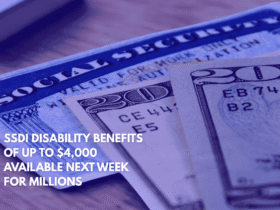If you receive Social Security Disability Insurance (SSDI) benefits, it’s important to stay informed about your payment schedule and the amounts you may receive in June 2025.
Payments are made based on the birthdate of the beneficiary, with different groups receiving their benefits at different times each month. Let’s explore what to expect for SSDI recipients in June 2025 and how the system works.
SSDI Payment Schedule for June 2025
The first round of SSDI payments for June 2025 will be made on Wednesday, June 11. This date is for beneficiaries whose birthdays fall between the 1st and 10th of any month. To be eligible for this payment, you must have started receiving SSDI benefits after May 1997.
For the month of June, here’s the payment schedule for different groups:
- June 11, 2025 (Wednesday): Beneficiaries born between the 1st and 10th of the month.
- June 18, 2025 (Wednesday): Beneficiaries born between the 11th and 20th.
- June 25, 2025 (Wednesday): Beneficiaries born between the 21st and 31st.
These payment dates are based on the official calendar of the Social Security Administration (SSA), which organizes payments according to birthdates.
Maximum and Average SSDI Payments
The maximum SSDI payment for those lucky enough to be in the highest group is $4,018 per month in 2025. This amount is generally for individuals who have a long work history and earned a higher income during their working years.
However, the average SSDI payment in 2025 is much lower. The typical SSDI benefit is around $1,581.88 per month. This is the statistical center value, representing the usual benefit most recipients receive.
In addition to regular SSDI payments, some beneficiaries may also qualify for Supplemental Security Income (SSI). If you’re eligible, a single applicant can receive up to $967 per month, while a couple applying together can receive as much as $1,450. These figures are in addition to SSDI benefits for those who qualify.
2.5% COLA Increase for 2025
Both SSDI and SSI beneficiaries will see a 2.5% cost-of-living adjustment (COLA) increase, effective through December 2025. This increase helps to offset inflation and rising living costs, ensuring that the benefits remain in line with the changing economy.

SSDI Eligibility Requirements
To qualify for SSDI benefits, you must meet certain work history and disability requirements:
- Work History: Generally, you must have accumulated 40 work credits over your lifetime. At least 20 credits must have been earned in the decade before your disability began. Younger workers may need fewer credits.
- Disability: Your medical condition must prevent you from working and engaging in “substantial gainful activity.” It must be expected to last at least 12 months or result in death.
- Income Limits: For 2025, if you’re a non-blind individual, your monthly earnings cannot exceed $1,530. If you’re legally blind, the limit is $2,550. Exceeding these limits could impact your SSDI eligibility.
Access to Medicare for SSDI Beneficiaries
After receiving SSDI benefits for a full 24 months, you will gain access to Medicare. This waiting period applies to most SSDI recipients. However, there are exceptions:
- Amyotrophic lateral sclerosis (ALS) patients qualify for immediate Medicare coverage.
- Individuals with end-stage renal disease (ESRD) can also qualify for Medicare without the 24-month waiting period.
Medicare coverage for SSDI beneficiaries includes Part A (hospital insurance) and Part B (outpatient services). Part B usually requires a premium, but there are assistance programs available to help cover the cost.











Leave a Reply